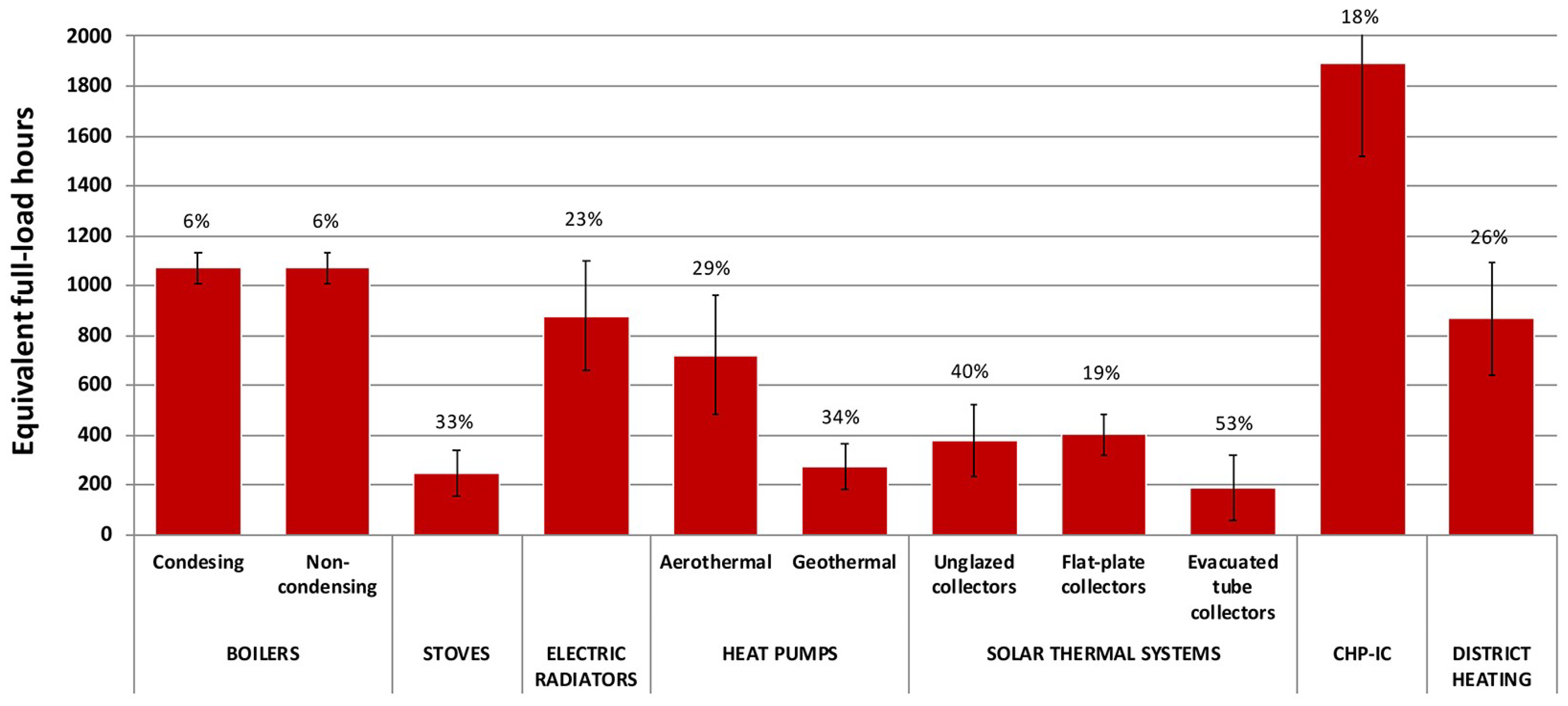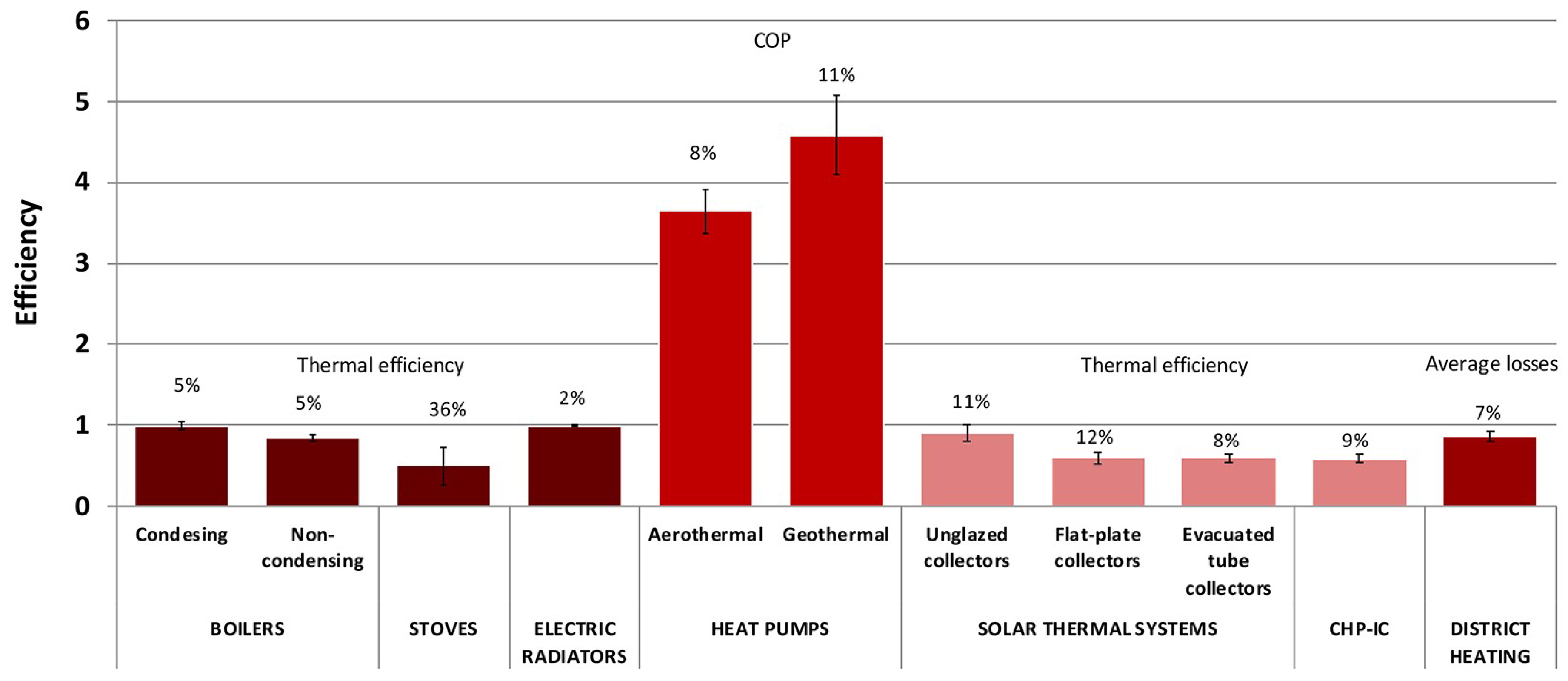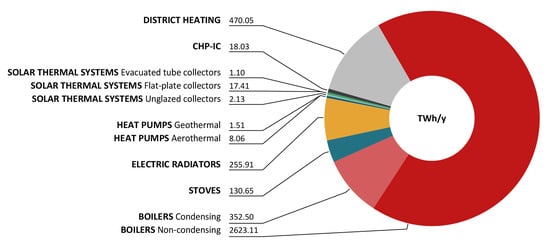Assessment of the Space Heating and Domestic Hot Water Market in Europe—Open Data and Results
Abstract
:1. Introduction
1.1. Data Inventory
1.2. Data Reliability
1.3. Data Definition and Comparability
2. Materials and Methods
- Boilers:
- -
- Non-condensing;
- -
- Condensing;
- Stoves;
- Electric radiators;
- Heat pumps (HPs):
- -
- Aerothermal;
- -
- Geothermal;
- Solar thermal systems (STS):
- -
- Unglazed collectors;
- -
- Flat-plate collectors;
- -
- Evacuated tube collectors;
- Combined heat and power—Internal combustion (CHP-IC);
- District heating (DH).
- Oil;
- Gas (natural gas);
- Coal;
- Renewables;
- Other fuels.
- Czech Republic and Slovakia;
- Bulgaria and Romania;
- Estonia, Latvia, and Lithuania.
- The use of average data at the EU level, when data for each MS were not available, and of efficiency coefficients constants for all MS were necessary to fill the existing gaps in EU databases on SH and DHW and to perform the analysis for estimating the European SH and DHW market. However, these hypotheses result in inaccuracies related to the correctness of the final data relatively to each MS.
- Correspondence of full-load hours, efficiency, and mean installed capacity were assumed in case of missing data for countries with geographical, socio-economic, and historical similarities. However, SH and DHW systems are not always conforming and there might be differences between regions. This might also be influenced by diversities in climatic conditions.
3. Results
4. Discussion
5. Conclusions
- A significant portion of the total EU energy consumption went to SH and DHW (more than 20%), reaching almost the value of 3900 TWh/y.
- The energy consumption of DH systems covered around 13% of the total, and exceeded that of condensing boilers. While DH system applications are growing throughout the EU, the replacement of older, conventional boilers progresses at a slower pace.
- The investigation also included information on the use of fuels for SH and DHW technologies at the EU28 level. Gas (i.e., natural gas) was the most diffused, while renewables were ranking lower. This was different for stoves and CHP-IC. Especially DH offered a high potential for the use of RES.
Author Contributions
Funding
Acknowledgments
Conflicts of Interest
References
- EC. 2030 Climate & Energy Framework. 2019. Available online: http://ec.europa.eu/clima/policies/strategies/2030/index_en.htm (accessed on 15 February 2019).
- EC. 2050 Low-Carbon Economy. 2019. Available online: https://ec.europa.eu/clima/policies/strategies/2050_en (accessed on 15 February 2019).
- EC. Paris Agreement. 2019. Available online: https://ec.europa.eu/clima/policies/international/negotiations/paris_en (accessed on 15 February 2019).
- Benejam, G.M.; Mata, É.; Kalagasidis, A.S.; Johnsson, F. Bottom-up characterization of the Spanish building stock for energy assessment and model validation. In Proceedings of the Retrofit 2012 Conference, Manchester, UK, 24–26 January 2012. [Google Scholar]
- EC. Consumption of Energy. 2019. Available online: http://ec.europa.eu/eurostat/statistics-explained/index.php/Consumption_of_energy (accessed on 16 February 2019).
- Economidou, M. Energy performance requirements for buildings in Europe. REHVA J. 2012, 92, 16–21. [Google Scholar]
- Pezzutto, S.; De Felice, M.; Fazeli, R.; Kranzl, L.; Zambotti, S. Status Quo of the Air-Conditioning Market in Europe: Assessment of the Building Stock. Energies 2017, 10, 1253. [Google Scholar] [CrossRef]
- EC. Energy Efficiency Trends in Buildings in the EU. 2012. Available online: https://energiatalgud.ee/img_auth.php/6/68/Enerdata._Energy_Efficiency_Trends_in_Buildings_in_the_EU._2012.pdf (accessed on 17 February 2019).
- EC. Buildings. 2019. Available online: https://ec.europa.eu/energy/en/topics/energy-efficiency/buildings (accessed on 18 February 2019).
- Tronchin, L.; Manfren, M.; Nastasi, B. Energy efficiency, demand side management and energy storage technologies—A critical analysis of possible paths of integration in the built environment. Renew. Sustain. Energy Rev. 2018, 95, 341–353. [Google Scholar] [CrossRef]
- IEA. Energy Efficiency Requirements in Building Codes, Energy Efficiency Policies for New Buildings. 2008. Available online: https://www.iea.org/publications/freepublications/publication/Building_Codes.pdf (accessed on 17 February 2019).
- EEA. Final Energy Consumption by Sector and Fuel. 2019. Available online: https://www.eea.europa.eu/data-and-maps/indicators/final-energy-consumption-by-sector-9/assessment-4 (accessed on 18 February 2019).
- IEA. Data Service. 2019. Available online: http://wds.iea.org/WDS/Common/Login/login.aspx (accessed on 18 February 2019).
- Vinnova. H2020 Visualization. 2019. Available online: http://h2020viz.vinnova.se/#/ (accessed on 18 February 2019).
- EC. Research and Innovation. 2019. Available online: https://ec.europa.eu/research/energy/eu/index_en.cfm?pg=projects&fp7page=10b (accessed on 18 February 2019).
- Bointner, R.; Pezzutto, S.; Sparber, W. Scenarios of public energy research and development expenditures: Financing energy innovation in Europe. Wiley Interdisciplin. Rev. Energy Environ. 2016, 5, 470–488. [Google Scholar] [CrossRef]
- Bointner, R.; Pezzutto, S.; Grilli, G.; Sparber, W. Financing Innovations for the Renewable Energy Transition in Europe. Energies 2016, 9, 990. [Google Scholar] [CrossRef]
- Pezzutto, S.; Fazeli, R.; De Felice, M.; Sparber, W. Future development of the air-conditioning market in Europe: An outlook until 2020. Wiley Interdisciplin. Rev. Energy Environ. 2016, 5, 649–669. [Google Scholar] [CrossRef]
- EC. An EU Strategy on Heating and Cooling. 2016. Available online: https://ec.europa.eu/energy/sites/ener/files/documents/1_EN_ACT_part1_v14.pdf (accessed on 29 April 2019).
- Pardo, N.; Vatopoulos, K.; Krook-Riekkola, A.; Moya, J.A.; Perez, A. Heat and Cooling Demand and Market Perspective. 2012. Available online: http://publications.jrc.ec.europa.eu/repository/bitstream/111111111/26989/1/ldna25381enn.pdf (accessed on 29 April 2019).
- EC. Energy Roadmap 2050. 2011. Available online: http://ec.europa.eu/smart-regulation/impact/ia_carried_out/docs/ia_2011/sec_2011_1565_en.pdf (accessed on 29 April 2019).
- Fleiter, T.; Elsland, R.; Rehfeldt, M.; Steinbach, J.; Reiter, U.; Catenazzi, G.; Jakob, M.; Rutten, C.; Harmsen, R.; Dittmann, F.; et al. Profile of Heating and Cooling Demand in 2015. Heat Roadmap Europe, 2017. Available online: https://heatroadmap.eu/wp-content/uploads/2018/11/HRE4_D3.1.pdf (accessed on 24 February 2019).
- Persson, U.; Werner, S. Quantifying the Heating and Cooling Demand in Europe. STRATEGO, 2015. Available online: http://www.heatroadmap.eu/resources/STRATEGO%20WP2%20-%20Background%20Report%204%20-%20Heat%20%26%20Cold%20Demands.pdf (accessed on 24 February 2019).
- Birchall, S.; Wallis, I.; Churcher, D.; Pezzutto, S.; Fedrizzi, R.; Causse, E. D2.1a—Survey on the Energy Needs and Architectural Features of the EU Building Stock. iNSPiRe, 2014. Available online: http://inspirefp7.eu/wp-content/uploads/2016/08/WP2_D2.1a_20140523_P18_Survey-on-the-energy-needs-and-architectural-features.pdf (accessed on 25 February 2019).
- Patronen, J.; Kaura, E.; Torvestad, C. Nordic Heating and Cooling. 2017. Available online: http://www.diva-portal.org/smash/get/diva2:1098961/FULLTEXT01.pdf (accessed on 24 February 2019).
- Boermans, T. Building Renovation in Europe—What are the Choices? 2012. Available online: https://www.eurima.org/uploads/ModuleXtender/Publications/90/Renovation_tracks_for_Europe_08_06_2012_FINAL.pdf (accessed on 24 February 2019).
- Von Manteuffel, B.; Petersdorff, C.; Bettgenhäuser, K.; Boermans, T. EU Pathways to a Decarbonised Building Sector. 2016. Available online: https://www.ecofys.com/files/files/ecofys-2016-eu-pathways-towards-a-decarbonised-building-sector.pdf (accessed on 25 February 2019).
- Sanner, B. 2020–2030–2050 Common Vision for the Renewable Heating & Cooling Sector in Europe. 2011. Available online: http://www.rhc-platform.org/fileadmin/Publications/RHC_BROCHURE_140311_web.pdf (accessed on 25 February 2019).
- Scoccia, R.; Toppi, T.; Aprile, M.; Motta, M. Absorption and compression heat pump systems for space heating and DHW in European buildings: Energy, environmental and economic analysis. J. Build. Eng. 2018, 16, 94–105. [Google Scholar] [CrossRef]
- Balaras, C.A.; Gaglia, A.G.; Georgopoulou, E.; Sevastianos, M.; Sarafidis, Y.; Lalas, D.P. European residential buildings and empirical assessment of the Hellenic building stock, energy consumption, emissions and potential energy savings. Build. Environ. 2007, 42, 1298–1314. [Google Scholar] [CrossRef]
- Leurent, M.; Da Costa, P.; Rämä, M.; Persson, U.; Jasserand, F. Cost-benefit analysis of district heating systems using heat from nuclear plants in seven European countries. Energy 2018, 149, 454–472. [Google Scholar] [CrossRef]
- EU. Hotmaps. 2019. Available online: https://www.hotmaps-project.eu/ (accessed on 18 February 2019).
- Pezzutto, S.; Zambelli, P. space_heating_cooling_dhw_bottom-up_SH+DHW.xlsx. 2019. Available online: https://gitlab.com/hotmaps/space_heating_cooling_dhw_demand/blob/master/data/space_heating_cooling_dhw_bottom-up_SH+DHW.xlsx (accessed on 18 February 2019).
- Pezzutto, S.; Zambelli, P. space_heating_cooling_dhw_bottom-up_SH+DHW.csv. 2019. Available online: https://gitlab.com/hotmaps/space_heating_cooling_dhw_demand/blob/master/data/space_heating_cooling_dhw_bottom-up_SH+DHW.csv (accessed on 18 February 2019).
- Creative commons. Attribution 4.0 International (CC BY 4.0). 2019. Available online: https://creativecommons.org/licenses/by/4.0/ (accessed on 18 February 2019).
- The Apache Software Foundation. Apache License. 2019. Available online: https://apache.org/licenses/LICENSE-2.0 https://apache.org/licenses/LICENSE-2.0 (accessed on 18 February 2019).
- Pezzutto, S.; Zambotti, S.; Croce, S.; Zambelli, P.; Garegnani, G.; Scaramuzzino, C.; Pascuas, R.P.; Zubaryeva, A.; Haas, F.; Exner, D.; et al. D2.3 WP2 Report—Open Data Set for the EU28. Hotmaps, 2018. Available online: https://www.hotmaps-project.eu/wp-content/uploads/2018/03/D2.3-Hotmaps_for-upload_revised-final_.pdf (accessed on 18 February 2019).
- Noussan, M.; Nastasi, B. Data Analysis of Heating Systems for Buildings—A Tool for Energy Planning, Policies and Systems Simulation. Energies 2018, 11, 233. [Google Scholar] [CrossRef]
- Noussan, M.; Roberto, R.; Nastasi, B. Performance Indicators of Electricity Generation at Country Level—The Case of Italy. Energies 2018, 11, 650. [Google Scholar] [CrossRef]
- EurObserv’ER. All Heat Pumps Barometers. 2018. Available online: https://www.eurobserv-er.org/category/all-heat-pumps-barometers/ (accessed on 18 February 2019).
- EUROHEAT&POWER. District Heating and Cooling—Country by Country—2015 Survey. 2015. Available online: http://www.euroheat.org/wp-content/uploads/2016/03/2015-Country-by-country-Statistics-Overview.pdf (accessed on 18 February 2019).
- Nowak, T.; Westring, P. European Heat Pump Market and Statistics Report. 2018. Available online: https://www.ehpa.org/market-data/market-report/ (accessed on 18 February 2019).
- EC. EU Buildings Database. Available online: https://ec.europa.eu/energy/en/eu-buildings-database (accessed on 18 February 2019).
- EHPA. The Online Stats Tool. 2019. Available online: http://www.stats.ehpa.org/hp_sales/country_cards/ (accessed on 18 February 2019).
- IGA. OUR DATABASES. 2019. Available online: https://www.geothermal-energy.org/explore/our-databases/ (accessed on 18 February 2019).
- Bertoldi, P.; Rezessy, S.; Lees, E.; Baudry, P.; Jeandel, A.; Labanca, N. Energy supplier obligations and white certificate schemes: Comparative analysis of experiences in the European Union. Energy Pol. 2010, 8, 1455–1469. [Google Scholar] [CrossRef]
- Martinopoulos, G.; Papakostas, K.T.; Papadopoulos, A.M. A comparative review of heating systems in EU countries, based on efficiency and fuel cost. Renew. Sustain. Energy Rev. 2018, 90, 687–699. [Google Scholar] [CrossRef]
- Clay, K. Power to the People: Energy in Europe over the Last Five Centuries. J. Econ. Hist. 2015, 75, 936–937. [Google Scholar] [CrossRef]
- Pezzutto, S.; Zambelli, P. space_heating_cooling_dhw_demand. 2019. Available online: https://gitlab.com/hotmaps/space_heating_cooling_dhw_demand (accessed on 18 February 2019).
- Open Knowledge International. Frictionless Data. Specifications and Software. 2019. Available online: https://frictionlessdata.io/ (accessed on 18 February 2019).
- Pezzutto, S.; Zambelli, P. Space Heating, Cooling and DHW Demand—EU28. 2019. Available online: https://gitlab.com/hotmaps/space_heating_cooling_dhw_demand/blob/master/README.md (accessed on 18 February 2019).
- SPDX Workgroup. Software Package Data Exchange® (SPDX®). 2019. Available online: https://spdx.org/ (accessed on 18 February 2019).
- Zambelli, P.; Pezzutto, S.; Garegnani, G.; Pignatelli, A.; Lehtsalu, L.; Kranzl, L.; Fritz, S. Data Management Plan. Hotmaps, 2018. Available online: https://www.hotmaps-project.eu/wp-content/uploads/2019/03/Hotmaps_D2.1_Data-Management-Plan_2018-09-28_final.pdf (accessed on 18 February 2019).
- Nouvel, R.; Zirak, M.; Coors, V.; Eicker, U. The influence of data quality on urban heating demand modeling using 3D city models. Comput. Environ. Urban Syst. 2017, 64, 68–80. [Google Scholar] [CrossRef]
- EU. Heat Roadmap Europe. 2019. Available online: http://www.heatroadmap.eu/ (accessed on 18 February 2019).
- EU. Stratego. 2014. Available online: http://stratego-project.eu (accessed on 19 February 2019).
- EC. Mapping and Analyses of the Current and Future (2020–2030) Heating/Cooling Fuel Deployment (Fossil/Renewables). 2019. Available online: https://ec.europa.eu/energy/en/studies/mapping-and-analyses-current-and-future-2020-2030-heatingcooling-fuel-deployment (accessed on 19 February 2019).
- Dengler, J.; Köhler, B.; Dinkel, A.; Bonato, P.; Azam, N.; Kalz, D. Work Package 2: Assessment of the Technologies for the Year 2012. Mapping and Analyses of the Current and Future (2020–2030) Heating/Cooling Fuel Deployment (Fossil/Renewables). 2016. Available online: https://ec.europa.eu/energy/sites/ener/files/documents/mapping-hc-final_report-wp2.pdf (accessed on 20 February 2019).
- Persson, U.; Möller, B.; Wiechers, E. Deliverable 2.3: A Final Report Outlining the Methodology and Assumptions used in the Mapping. Heat Roadmap Europe, 2017. Available online: http://www.heatroadmap.eu/resources/HRE4_D2.3.pdf (accessed on 20 February 2019).
- Connolly, D.; Hansen, K.; Drysdale, D.; Lund, H.; Vad Mathiesen, B.; Werner, S.; Persson, U.; Möller, B.; Wilke, O.C.; Bettgenhäuser, K.; et al. Enhanced Heating and Cooling Plans to Quantify the Impact of Increased Energy Efficiency in EU Member States. Stratego, 2016. Available online: http://stratego-project.eu/wp-content/uploads/2014/09/STRATEGO-WP2-Executive-Summary-Main-Report.pdf (accessed on 20 February 2019).
- Fedrizzi, R.; Marchetti, R. iNSPiRe, Bolzano, Italy. Deliverable 2.1 Intermediate analysis of the heating and cooling industry. Support to key activities of the European technology platform on renewable heating and cooling. Unpublished work. 2016. [Google Scholar]
- Mauthner, F.; Weiss, W.; Spörk-Dür, M. Solar Heat Worldwide. 2017. Available online: http://www.iea-shc.org/Data/Sites/1/publications/Solar-Heat-Worldwide-2017.pdf (accessed on 20 February 2019).
- Mauthner, F.; Weiss, W.; Spörk-Dür, M. Solar Heat Worldwide. 2016. Available online: http://www.iea-shc.org/Data/Sites/1/publications/Solar-Heat-Worldwide-2016.pdf (accessed on 20 February 2019).
- EC. ENERGY DATA. 2019. Available online: http://ec.europa.eu/eurostat/web/energy/data (accessed on 20 February 2019).
- EU. TABULA WebTool. 2019. Available online: http://webtool.building-typology.eu/#bm (accessed on 21 February 2019).
- Pezzutto, S.; Toleikyte, A.; De Felice, M. Assessment of the Space Heating and Cooling Market in the EU28: A Comparison between EU15 and EU13 Member States. Int. J. Contemp. Energy 2015, 1, 35–48. [Google Scholar]
- Welch, T. Heat Pump Technology. 2009. Available online: https://www.cibsejournal.com/cpd/modules/2009-05/ (accessed on 21 February 2019).
- Nouvel, R.; Cotrado, M.; Pietruschka, D. European Mapping of Seasonal Performances of Air-Source and Geothermal Heat Pumps for Residential Applications. In Proceedings of the CISBAT 2015, Lausanne, Switzerland, 9–11 September 2015. [Google Scholar]
- Pezzutto, S. Analysis of the space heating and cooling market in Europe. Ph.D. Thesis, University of Natural Resources and Life Sciences, Vienna, Austria, 22 May 2014. [Google Scholar]
- Werner, S. Possibilities with more District Heating in Europe. Ecoheatcool, 2006. Available online: https://www.euroheat.org/wp-content/uploads/2016/02/Ecoheatcool_WP4_Web.pdf (accessed on 21 February 2019).
- Insee. Coefficient of Variation/CV. 2019. Available online: https://www.insee.fr/en/metadonnees/definition/c1366 (accessed on 23 February 2019).
- Lee, C.F.; Lee, J.C.; Lee, A.C. Statistics for Business and Financial Economics, 2nd ed.; World Scientific Publishing: Singapore, 2000; pp. 103–104. [Google Scholar]
- Malta’s Office of The Prime Minister (Energy and Projects). Malta’s National Energy Efficiency Action Plan. 2017. Available online: https://ec.europa.eu/energy/sites/ener/files/documents/mt_neeap_2017.pdf (accessed on 22 February 2019).
- Andrews, D.; Riekkola, A.K.; Tzimas, E.; Serpa, J.; Carlsson, J.; Pardo-Garcia, N.; Papaioannou, I. Background Report on EU-27 District Heating and Cooling Potentials, Barriers, Best Practice and Measures of Promotion. 2012. Available online: https://setis.ec.europa.eu/system/files/1.DHCpotentials.pdf (accessed on 25 February 2019).
- Werner, S. International review of district heating and cooling. Energy 2017, 137, 617–631. [Google Scholar] [CrossRef] [Green Version]
- Gupta, A.; Bai, A.S. Europe Boiler Market Growth 2017–2024—Industry Size, Share Report. 2018. Available online: https://www.gminsights.com/industry-analysis/europe-boiler-market (accessed on 25 February 2019).
- UNEP. Domestic Hot Water for Single Family Houses. 2015. Available online: http://www.estif.org/fileadmin/estif/content/publications/downloads/UNEP_2015/factsheet_single_family_houses_v05.pdf (accessed on 25 February 2019).
- Index mundi. Demographics: Population. 2017. Available online: https://www.indexmundi.com/map/ (accessed on 25 February 2019).
- Fuentes, E.; Arce, L.; Salom, J. A review of domestic hot water consumption profiles for application in systems and buildings energy performance analysis. Renew. Sustain. Energy Rev. 2018, 81, 1530–1547. [Google Scholar] [CrossRef]
- Pezzutto, S.; Zambelli, P. space_heating_cooling_dhw_population_households.xlsx. 2019. Available online: https://gitlab.com/hotmaps/space_heating_cooling_dhw_demand/blob/master/data/space_heating_cooling_dhw_population_households.xlsx (accessed on 25 February 2019).
- Pezzutto, S.; Zambelli, P. space_heating_cooling_dhw_population_households.csv. 2019. Available online: https://gitlab.com/hotmaps/space_heating_cooling_dhw_demand/blob/master/data/space_heating_cooling_dhw_population_households.csv (accessed on 25 February 2019).
- EU. Commission Regulation (EU) No 813/2013 of 2 August 2013 Implementing Directive 2009/125 /EC of the European Parliament and of the Council with Regard to Ecodesign Requirements for Space Heaters and Combination Heaters. 2013. Available online: https://eur-lex.europa.eu/legal-content/EN/TXT/PDF/?uri=CELEX:32013R0813&from=EN (accessed on 25 February 2019).
- Epp, B. Top District Heating Countries—EUROHEAT&POWER 2015 Survey Analysis. 2015. Available online: https://www.euroheat.org/news/district-energy-in-the-news/top-district-heating-countries-euroheat-power-2015-survey-analysis/ (accessed on 25 February 2019).
- EUROHEAT&POWER. European Heating Sector Well Positioned for Renewables Integration. 2017. Available online: https://www.euroheat.org/news/european-heating-sector-well-positioned-renewables-integration/ (accessed on 25 February 2019).
- Gustavsson, L. District heating systems and energy conservation—Part II. Energy 1994, 19, 93–102. [Google Scholar] [CrossRef]
- IRENA. Renewable Energy Indistrict Heating and Cooling. A Sector Roadmap for Remap. 2017. Available online: https://www.irena.org/-/media/Files/IRENA/Agency/Publication/2017/Mar/IRENA_REmap_DHC_Report_2017.pdf (accessed on 28 February 2019).
- Wangab, D.; Orehounigab, K.; Carmelieta, J. Investigating the potential for district heating networks with locally integrated solar thermal energy supply. Energy Proc. 2017, 122, 1057–1062. [Google Scholar] [CrossRef]
- Olsthoorna, D.; Haghighata, F.; Mirzaeib, P.A. Integration of storage and renewable energy into district heating systems: A review of modelling and optimization. Sol. Energy 2016, 136, 49–64. [Google Scholar] [CrossRef]




| Source | Amount of Operative Units | Installed Capacities | Equivalent Full-Load Hours | Energy Efficiency Coefficients | Public Available |
|---|---|---|---|---|---|
| EurObserv’ER [40] | × | Yes | |||
| EUROHEAT&POWER [41] | × | Yes | |||
| HRE4 project [55] | × | × | × | No | |
| STRATEGO project [56] | × | × | × | No | |
| Tender ENER/C2/2014-641 [57] | × | × | × | Yes | |
| Dengler et al. 2012 [58] | × | × | × | Yes | |
| Persson et al. 2017 [59] | × | × | × | Yes | |
| Connolly et al. 2016 [60] | × | × | × | Yes | |
| Fedrizzi et al. 2016 [61] | × | × | No | ||
| Mauthner et al. 2017 [62] | × | × | × | Yes | |
| Mauthner et al. 2016 [63] | × | × | × | Yes | |
| TABULA project [65] | × | × | Yes | ||
| Nouvel et al. 2015 [68] | × | No | |||
| Pezzutto 2014 [69] | × | × | × | No |
| Oil | Gas (Natural Gas) | Coal | Renewables | Other Fuels | |
|---|---|---|---|---|---|
| Boilers-Condensing | 33.77% | 66.23% | NA | NA | NA |
| Boilers-Non-condensing | 38.30% | 54.30% | 2.28% | 5.12% | NA |
| Stoves | NA | NA | NA | 100.00% | NA |
| CHP-IC | 7.39% | 43.73% | 18.62% | 22.84% | 7.42% |
| DH | 4.45% | 38.35% | 28.76% | 26.02% | 2.42% |
| Comparison to the Present Study’s Result | Energy Consumption (TWh/y) | Deviation | Reference Year | Source |
|---|---|---|---|---|
| Close | ~4025 | 3% | 2015 | [22] |
| Close | ~3980 | 3% | 2012 | [25] |
| Close | ~4150 | 6% | 2010 | [23] |
| Lower | ~3400 | 12% | 2012 | [26] |
| Lower | ~2760 | 29% | 2014 | [24] |
| Lower | ~2070 | 47% | 2015 | [27] |
| Higher | ~4450 | 13% | 2006 | [28] |
| Higher | ~4715 | 18% | 2006/2007 | [29] |
| Higher | ~5990 | 35% | 2013 | [30] |
© 2019 by the authors. Licensee MDPI, Basel, Switzerland. This article is an open access article distributed under the terms and conditions of the Creative Commons Attribution (CC BY) license (http://creativecommons.org/licenses/by/4.0/).
Share and Cite
Pezzutto, S.; Croce, S.; Zambotti, S.; Kranzl, L.; Novelli, A.; Zambelli, P. Assessment of the Space Heating and Domestic Hot Water Market in Europe—Open Data and Results. Energies 2019, 12, 1760. https://doi.org/10.3390/en12091760
Pezzutto S, Croce S, Zambotti S, Kranzl L, Novelli A, Zambelli P. Assessment of the Space Heating and Domestic Hot Water Market in Europe—Open Data and Results. Energies. 2019; 12(9):1760. https://doi.org/10.3390/en12091760
Chicago/Turabian StylePezzutto, Simon, Silvia Croce, Stefano Zambotti, Lukas Kranzl, Antonio Novelli, and Pietro Zambelli. 2019. "Assessment of the Space Heating and Domestic Hot Water Market in Europe—Open Data and Results" Energies 12, no. 9: 1760. https://doi.org/10.3390/en12091760









